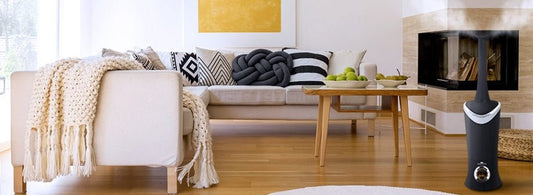Improve the Air You Breathe - Add Indoor Plants to Your Home
You don’t have to live with musty, stale air inside your home anymore. While older homes may have plenty of fresh air coming through drafty windows and exterior doors, you’re probably out of luck if you live in a newer home.
New homes are sealed tight so fresh air has almost no chance to work its way inside. So, what’s a person to do if you want to help improve the air quality inside your home or apartment? Adding a variety of indoor plants, known for their air improving qualities, is one way to solve the problem.
Another great way to improve the air inside your home is to use products that help you Sleep Better, Feel Better and Look Better. Air Innovations® makes an entire line of humidifiers, fans and aromatherapy diffusers to improve the air you breathe and help you get a better night's sleep.

NASA Clean Air Study
The National Aeronautics and Space Administration (NASA) conducted a study a few years ago to decide which plants could be grown inside to help improve indoor air quality. The NASA Clean Air Study – in association with the Associated Landscape Contractors of America (ALCA) – came up with a list of 12 plants that naturally help remove toxins, including formaldehyde, from the air. Removing indoor air pollutants is very important when it comes to treating homes or businesses labeled with “sick building syndrome”.
The study, “Interior Landscape Plants for Indoor Air Pollution Abatement”, was first published in 1989. The reasoning behind conducting the study was that in the 1970’s, as buildings became more energy-efficient, this reduced fresh air exchange inside the home. These airtight, super insulated homes resulted in people experiencing a variety of problems including skin rashes, itchy eyes, drowsiness, headaches, respiratory congestion and other allergy-like symptoms. Office buildings and homes are also filled with a variety of materials and equipment, such as paints, upholstery fabrics and electronics, which off-gas volatile compounds into the home further contributing to the indoor air pollution problem.
Dr. B.C. Wolverton was the principal investigator for the NASA/ALCA study, which summarized that “All of these factors collectively contribute to a phenomenon called "sick building syndrome." One world health organization recently estimated that approximately 30 percent of all new or remodeled buildings have varying degrees of indoor air pollution. Problems of this type have been reported in the United States and Canada as well as in most other highly developed nations of the western world.”
Best Houseplants to Improve Air Quality
The study concluded that houseplants, that grow well under low-light level conditions, have the potential to remove trace organic pollutants and help improve indoor air quality in energy-efficient buildings. The study also suggested using activated carbon filters and fans along with the houseplants for the best results.
Since the NASA study, more plants have been tested for their ability to remove indoor pollutants thus improving air quality. Here are just a few suggestions of what plants you can grow indoors to help cleanse and purify the air in your home or office. As a bonus, we only picked plants that are also non-toxic to cats and dogs, so you don’t have to worry about your fur babies accidentally snacking on the greenery in your home.
Common Name: Broadleaf Lady Palm
Latin Name: Rhapis excelsa
Removes: formaldehyde, xylene, toluene and ammonia

Common Name: Gerbera Daisy
Latin Name: Gerbera jamesonii
Removes: benzene, formaldehyde, trichloroethylene

Common Name: Dwarf Date Palm
Latin Name: Phoenix roebelenii
Removes: formaldehyde, xylene and toluene

Common Name: Boston Fern
Latin Name: Nephrolepis exaltata ‘Bostoniensis’
Removes: formaldehyde, xylene and toluene
Common Name: Lilyturf
Latin Name: Liriope spicata
Removes: formaldehyde, xylene, toluene and ammonia
Common Name: Moth Orchids
Latin Name: Phalaenopsis spp.
Removes: xylene and toluene

Common Name: Spider Plant
Latin Name: Chlorophytum comosum
Removes: formaldehyde, xylene and toluene
Common Name: Bamboo Palm
Latin Name: Chamaedorea seifrizii
Removes: formaldehyde, xylene and toluene
More Plants That Improve Air Quality
Just about any plant that can be grown indoors will help improve air quality in your home, apartment or office building. Use caution when using certain plants in your home; Aloe Vera, dracaena, English ivy, weeping fig, chrysanthemum and peace lily can be toxic if ingested.
Providing proper lighting, watering as needed for the plants’ requirements and fertilizing on a regular basis are all keys to maintaining healthy plants at home. You also need to watch for signs of bug infestation or dust – use a damp paper towel to gently wipe off any dust or pests that accumulates on the leaves.
Plants, and people too, need plenty of fresh, circulating air to keep them healthy. To help rid your home of stale, stagnant air, a combination of AC, ceiling fans and room fans, such as Air Innovations Swirl Cool 2-in-1 Fan, will help keep the air circulating in your home.
We hope your found these tips for cleaning the indoor air in your home helpful. If you’re looking for other options to improve air quality at home, check out more amazing Air Quality Trends on the Air Innovations website.











